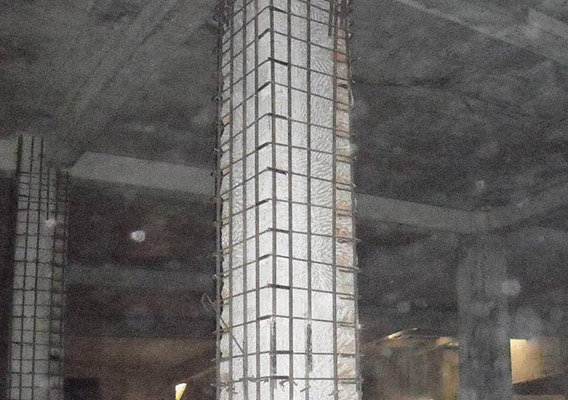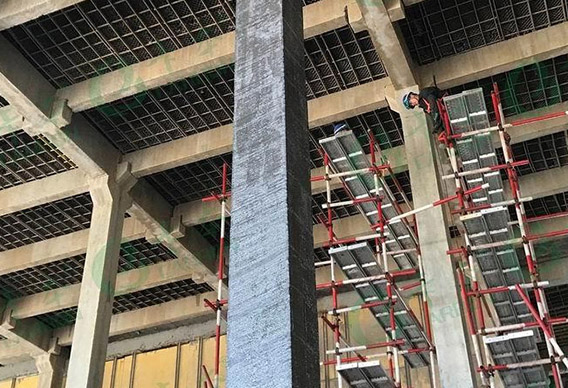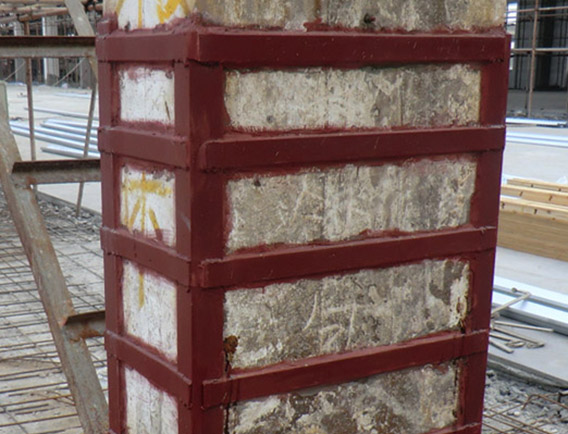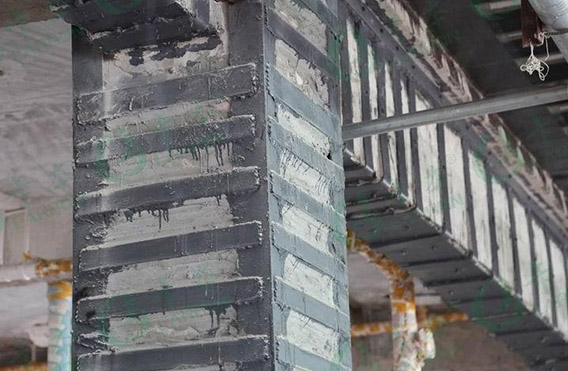Due to the constant changes in loads, environments, etc., concrete columns often suffer from reduced durability and insufficient strength or stiffness. As the main load-bearing structure in the building, it is necessary to reinforce the defective cylinder. There are many methods for reinforcing concrete pillars. The four commonly used ones are the enlarged section reinforcement method, the externally bonded steel reinforcement method, the bonded steel reinforcement method, the carbon fiber cloth reinforcement method, and the wire winding method.
1. Increasing the column section reinforcement method
Increasing the column section reinforcement method is to cover the concrete on one side, both sides or all sides of the concrete column according to the force of the column, and increase the cross-sectional area of the structure and the reinforcement to improve the structural bearing capacity and increase the strength and rigidity of the column.
In the concrete reinforcement, the increased section method is especially suitable for situations where the bearing capacity is insufficient due to the small cross section of the cylinder. In order to achieve the best reinforcement effect in the concrete by the enlarged section method, it is necessary to ensure that the strength grade of the concrete basement cannot be lower than C13. The reinforcement steel bar for reinforcement should not be less than 14 mm, and the concrete of different types, cross-section forms and stress conditions columns need to be in different configurations.
Advantages: simple construction process, strong adaptability, and long-term experience;
Disadvantages: The construction wet operation time is long. The load is limited during the concrete curing, and the self-weight of the structure is increased after the reinforcement, and the building use space is reduced.

2. Carbon fiber cloth reinforcement method
Carbon fiber cloth reinforcement is suitable for reinforcement of concrete columns with axial compression and large eccentric compression and insufficient ductility. The continuous bearing capacity and ductility of the concrete column can be improved by continuously wrapping the circumferential bundle, that is, without the spacing of the ring. The carbon fiber cloth can also be bonded into the annular hoop to improve the bearing capacity of the concrete column.
The reinforcement of carbon fiber cloth shall ensure that the strength of the substrate shall not be lower than C15, and the tensile strength of the positive tensile joint shall not be less than 1.5 MPa, and the length of the overlap of the carbon fiber cloth in the circumferential bundle shall not be less than 50 mm.
Advantages: light weight and high strength, generally no need to overlap. It can adapt to the paste requirements of curved shape concrete, corrosion resistance, moisture resistance, convenient construction;
Disadvantages: There is a limit to the temperature of the environment in which it is used, and special protection is required. If it is not properly protected, it is vulnerable to fire and man-made damage.

3, Winding wires method
In order to improve the ductility of the concrete column, it is often reinforced by a wire winding method. The reinforcement principle of the wire-wound reinforcement method is a direct reinforcement method for improving the bearing capacity and ductility of the concrete member by winding the annealed steel wire to restrain the concrete of the strengthened compression member.
When the winding method is adopted, if the section of the column is square, the ratio of the long side dimension to the short side dimension should not be greater than 1.5, and the four corners of the column should be passivated, and the rounded diameter should not be less than 30 mm. This method has the same effect as the above-mentioned affixed carbon fiber cloth reinforcement method, and it is a reinforcement method for improving the ductility of the member.
4. Column outer steel reinforcement method
The column outer steel reinforcement method is a reinforcement method in which the steel is overlaid on the two or four corners of the concrete column, and the angle steel is welded on the flat steel hoop to enhance its rigidity and stress performance, and is widely used in the reinforcement of the frame column.
The column outer steel reinforcement method is divided into dry type and wet type. The dry type reinforcement is that there is no connection between the angle steel and the original column, or the cement mortar can not ensure the effective transmission of the joint surface shear force. The deformation between the angle steel and the column is difficult to coordinate. Wet reinforcement is a method of using latex cement, polymer mortar or epoxy resin chemical grouting between the angle steel and the original column, so that the steel and the column can work together. The dry outsourcing reinforcement construction is simple, but the wet outsourcing reinforcement has obvious effects on the improvement of the bearing capacity. Therefore, in practice, the wet outsourcing reinforcement is widely used.

5. Sticking steel reinforcement method
The bonded steel reinforcement method is an out-of-gap angle steel and a clad steel plate. While the newly added section increases the bearing capacity of the column, the original concrete column produces a good three-direction stress state due to the lateral restraint of the new steel plate hoop. Therefore, the bearing capacity of the column can be greatly improved, and the deformation resistance of the column is also improved.
Advantages: When the cross-sectional area of the column is not increased much, the bearing capacity of the column is greatly improved.

These five concrete column reinforcement methods have their own characteristics. The reinforcement method can not be easily determined by the experience or construction convenience during the reinforcement, and it needs to be selected according to the specific conditions. In addition, the selection of safe and secure reinforcement materials is just as important as the proper reinforcement method.
Link to this article: https://www.njmkt.net/Mobile/MArticles/5zhntzzjgf.html